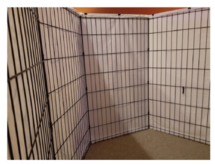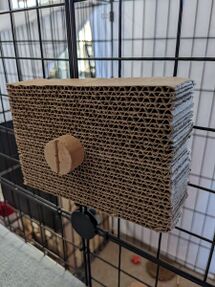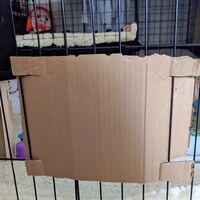Training FAQ
How do I encourage a rabbit to chew on toys and not unacceptable items?
Have the toys and the unacceptable items next to each other and watch your rabbit. If the rabbit goes for the bad object, clap or make some other sort of loud noise to make the bunny stop, and immediately redirect them towards the acceptable toy. If the rabbit chews the proper toys, feed them a treat.
Set the rabbit up so that they will have a clear boundary of what is okay for them to destroy and what is not. Make the acceptable option extra tempting and rewarding to encourage them to choose the correct and good option rather than deal with something that results in startling noises.
However, please note that you cannot teach a rabbit to 100% consistently not chew an object that is possibly within their reach. If you have cables or other furniture that you do not want possibly destroyed, keep them completely inaccessible with proper bunny-proofing, and do not rely solely on the behavioral training above.
My rabbit keeps me up by chewing their cage bars all night. How do I make them stop?
Make sure you are not giving your rabbits any attention when they rattle the bars or it can be a self-reinforcing behavior. It is also important to break this behavior for their health because chewing on cage bars can cause incisor malocclusion in rabbits, which can be an expensive problem to treat.[1]:440
Some reasons for cage-bar chewing:
- Not large enough housing enclosure.
- Not enough exercise.
- Frustration at the inability to go past the bars.
- Boredom.
Try changing up their environment in the cage regularly to make them more curious about their surroundings and cover the sections of the pen or cage that they are rattling with zip-tied cardboard. You can also try blocking their view and covering the cage bars with a bed sheet or solid object from the outside. Enriching their environment with shelters to hide in and a raised area to hop on and use as a lookout or resting place can help decrease bar-gnawing.[2] Ensuring there is fresh hay at all times will also help with decreasing their stress.[3]
If you feed your rabbit pellets, scatter them everywhere so your bunny will take longer to find and eat them all. Research has also shown that feeding supplementary pellets in the afternoon rather than the morning can help prevent the behavior.[4]
As usual, be sure to provide plenty of acceptable chew toys, and swap those out regularly as well to make it interesting. Ideas for various toys to entertain your rabbit can be found in Toys.
Note that while some rabbit owners endorse the use of sprays and scents, such as vinegar or bitter apple spray, to deter chewing, they are generally not reliable tactics to prevent rabbits from chewing, and using unsafe scents and sprays may endanger your rabbit instead. When possible, consider blocking access and redirecting your rabbit's chew energy elsewhere instead of relying on sprays.
How can I get my rabbit to voluntarily run back to their cage?
Generally, their pellets and veggies for bedtime make a great bribe to make rabbits run home on their own. Try saving a portion and making a distinctive sound or call their names to have them learn to run home to get these tasty foods.
In the meantime, we would suggest fencing off an area for exercise in order to make it easier to herd the rabbit back to their cage or pen.
If your rabbit cannot jump in their pen or cage on their own due to location, we would highly suggest modifying it so that you do not need to handle them to move them in and out of the housing.
See also
References
- ↑ Oglesbee, B. (2011). Blackwell's five-minute veterinary consult: Small mammal. (2nd ed.).
- ↑ Hansen, L.T., et al. (1999). The effect of environmental enrichment on the behaviour of caged rabbits (Oryctolagus cuniculus). Retrieved 17 Feb 2017 from https://pdfs.semanticscholar.org/bc13/20d2d0555a6a9e481deb676b5ea4fa0f4ab5.pdf
- ↑ Berthelsen, H., et al. (1999). The Effect of Hay on the Behaviour of Caged Rabbits (Oryctolagus Cuniculus). Retrieved 17 Feb 2017 from https://www.researchgate.net/publication/233557132_The_Effect_of_Hay_on_the_Behaviour_of_Caged_Rabbits_Oryctolagus_Cuniculus
- ↑ Krohn, T.C., et al. (1998). The effects of feeding and housing on the behaviour of the laboratory rabbits. Retrieved 17 Feb 2017 from http://lan.sagepub.com/content/33/2/101.full.pdf




